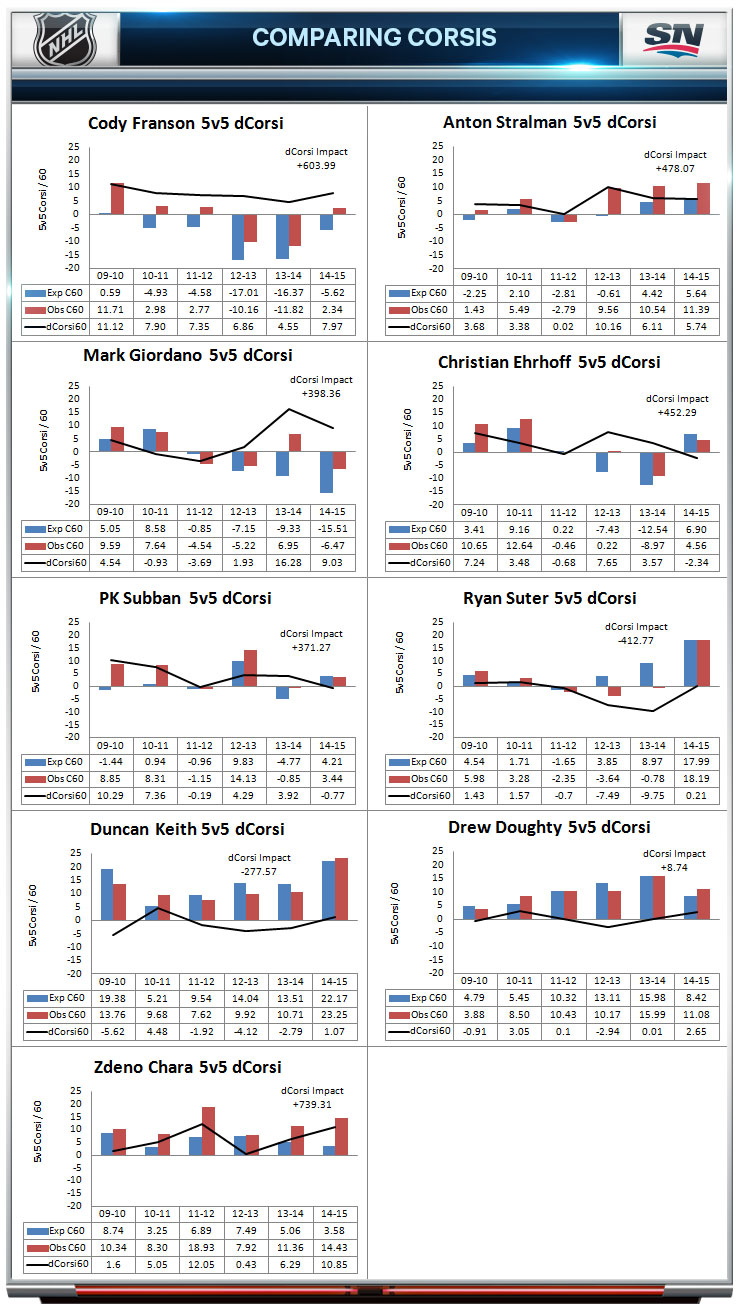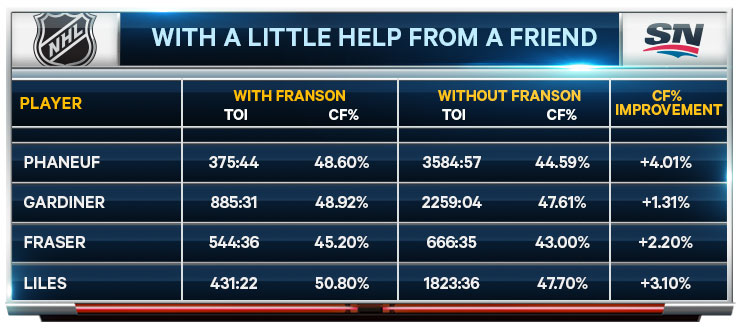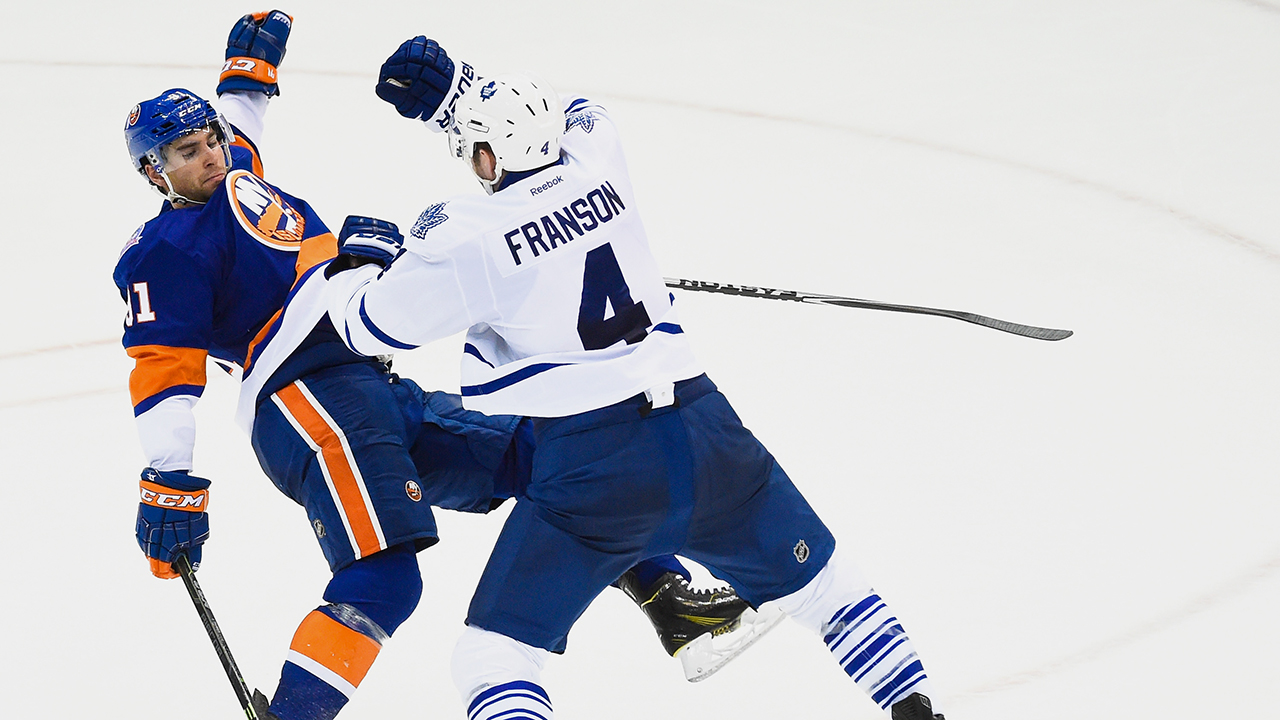There is no season more important to an NHL player’s career financially than the one immediately prior to his first dip into the unrestricted free agency pool. For Cody Franson, that goes double. The Maple Leafs have spent the past three summers in a rolling cycle of increasingly acrimonious RFA battles with him, low-balling the blueliner to the point that he has publicly questioned his role with the team and ended up signing a series of one-year contracts. For all the good he’s done—148 points and a plus-15 rating in 343 career NHL games beginning in 2009-10—he’s generally been viewed negatively: slow afoot, soft despite his size and a defensive liability.
While the first critique may well be true, thanks to the emergence of analytical measures, we can prove that the others simply are not. And we can also say with certainty that if the Leafs allow Franson, who will turn 28 in August, to get to the open market this summer, he will be one of the most valuable—and most expensive—UFA’s available.
It’s fair to say that Franson didn’t play a physical style early in his career, but the six-foot-five blueliner has improved that aspect of his game significantly. If we examine the road-hits rankings of NHL defencemen (to minimize home ice biases around the NHL), Franson is seventh since the start of 2012-13—ahead of “big hitting” teammates Dion Phaneuf (eighth) and Roman Polak (10th).
Franson’s defensive critiques centre on the notion that he is on the ice for the “big goals” against with far too much regularity despite being “sheltered” defensively. Since 2012-13 he has the sixth-highest Goals Against per 60 rate amongst NHL D-men at 5-on-5 (2.89), which implies that he is inferior defensively. But that perception ignores significant factors like usage, goaltending and the quality of teammates he plays with. Context matters when analyzing NHLers, far more than many people realize.
Since 2012-13 the On-Ice SV% at 5v5 for Franson is .917 (90th out of 123 defenders with 1,000-plus minutes of ice time). The median On-Ice SV% for that same group is .922. However, he also started 38.1 percent of his shifts in the Defensive Zone—the highest rate of any of the 123 players in the group. And when comparing possession metrics, Franson’s teammates had a weighted average Corsi For % of 43.9 percent, 121st out of the 123 over the same two-year span—Jake Gardiner ranked 123rd by the same metric.
So Franson arguably was starting in the toughest situations in the entire NHL the past two seasons—he had the highest proportion of Defensive Zone starts, with the worst teammates in terms of possession, in front of below average goaltending. It seems curious that anyone would argue that Franson has been “sheltered” defensively based on those statistics. But they do, because they’re not looking beyond the eye test.
Delta Corsi (dCorsi) is a metric I have spent more than two years refining. Essentially, it accounts for usage factors like 5v5 time on ice, zone starts and overall quality of teams and linemates to calculate an Expected Corsi or Fenwick result, which can then be compared to actual observed results. The difference between observed and expected is the player’s dCorsi. The values are determined as rate stats, but we can convert dCorsi to a dCorsi impact—a skater’s dCorsi multiplied by their 5v5 TOI. The players with the largest dCorsi impact are essentially the most effective possession players in the NHL—i.e. the skaters playing the most minutes who consistently outperform expectations.
To quantify Franson’s value as an NHL blueliner, we can look at a couple of different aspects of his effects on a team. First, we can use dCorsi to compare him to other top-end defenders over the course of his career. Secondly, we can determine the impact he makes on his individual defence partners using WOWY (With or Without You) analysis.
Below are a series of graphs comparing Franson’s career performance to a selection of other top blueliners, in terms of Expected Corsi 60, Observed Corsi 60, and the resulting dCorsi.

The only defender in the group who has a better combined dCorsi Impact since 2009-10 is Zdeno Chara and only Mark Giordano faces comparably challenging usage. Simply put, Franson has a similar possession impact to many of the NHL’s top defenders. It’s an extremely underrated aspect of his game—and one that also greatly improves his teammates.
During his tenure with the Leafs, Franson has played primarily with four different partners: Dion Phaneuf this season, Jake Gardiner last season, Mark Fraser in 2012-13 and John-Michael Liles in ’11-12. A WOWY analysis shows that he has significantly improved the possession results of all of them.

With more and more teams taking possession numbers into account when looking at free agents, the above numbers can only bode well for Franson’s contract negotiations.
NHL teams also regularly pay a premium for offensive production. Franson’s scoring impacts are far-more well known than his possession impacts, and have been consistent throughout his career. Since entering the NHL in 2009, amongst defenders with 2,500-plus minutes at 5v5, Franson ranks seventh overall in points per 60 minutes.

Similarly, he is 20th in points per 60 minutes of power-play time among defencemen with 500-plus minutes of PP TOI over the same 2009-2015 time span. What the 5v5 and PP scoring numbers mean is that, offensively, Franson is among the top-20 defencemen in the NHL. The only other with a comparable offensive skill set likely to be a UFA this summer is Mike Green—who already has a cap hit of $6,083,333, and could see a raise.
To put Franson’s potential payday into further perspective, we can look at two of the top UFA blueliners from last summer. Largely on the basis of his defensive and possession results alone, Anton Stralman secured a five-year contract with the Tampa Bay Lightning at a cap hit of $4,500,000. On that same listing of 5v5 pts/60 shown above, Stralman ranks 131st. Playing for the high-powered Penguins last season, Matt Niskanen had more points overall, but ranks just 70th from 2009-2015 in 5v5 pts/60. He also isn’t the possession player Franson is. And still, he signed for seven years with a cap hit of $5,750,000.
To put it plainly, Franson produces offensively amongst the elite D-men in the NHL. His possession impacts are amazingly consistent, and have never been negative. He has shown an ability to both reduce shot-attempts against and increase shot-attempts for. And goals-for and against improve significantly when he is on the ice compared to what one would expect based on his usage.
Franson’s on-ice impact and potential UFA status this summer combine to create a very unique combination, and rumours are already spreading that his camp will be seeking a deal worth $5 million-plus annually. If teams enter into negotiations with their eyes open—aware of his perceived flaws and relatively regular defensive miscues, while also understanding his overall impact vastly outweighs those negatives—a bidding war is inevitable. Unfortunately for the Leafs the past few seasons, they have been sitting on—and making an adversary of—one of the most undervalued assets in the NHL. They may well regret playing hardball in past negotiations.
However things play out, Franson is set to become one of the wealthiest players in the NHL a year from now, and for a long time to come. Because despite what the eye test says, he deserves it.

